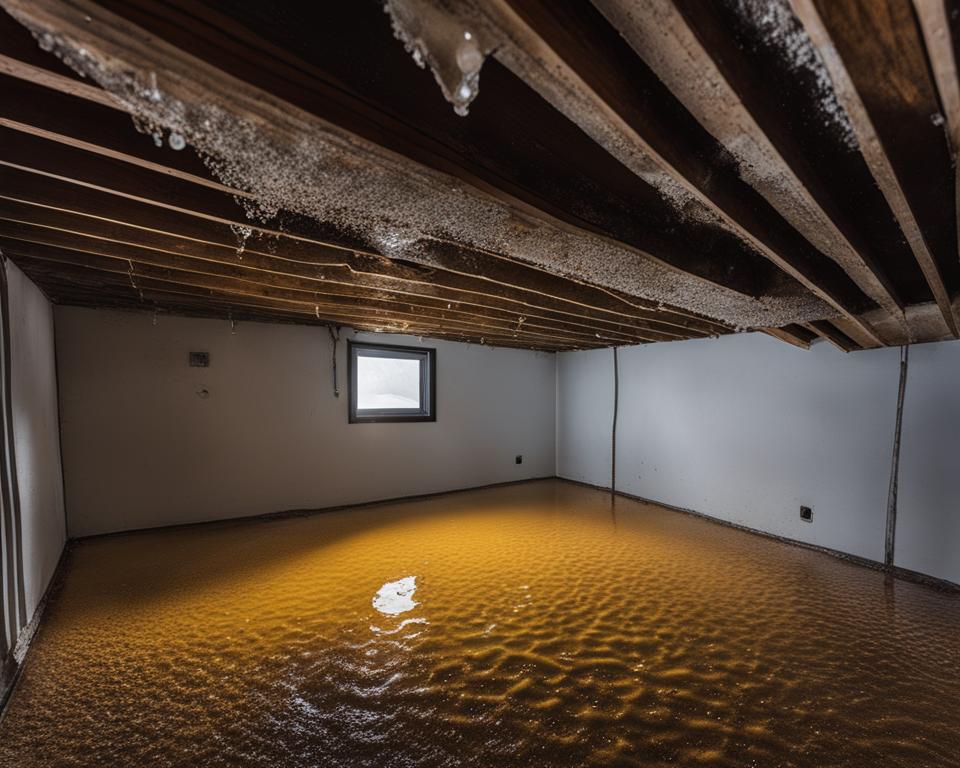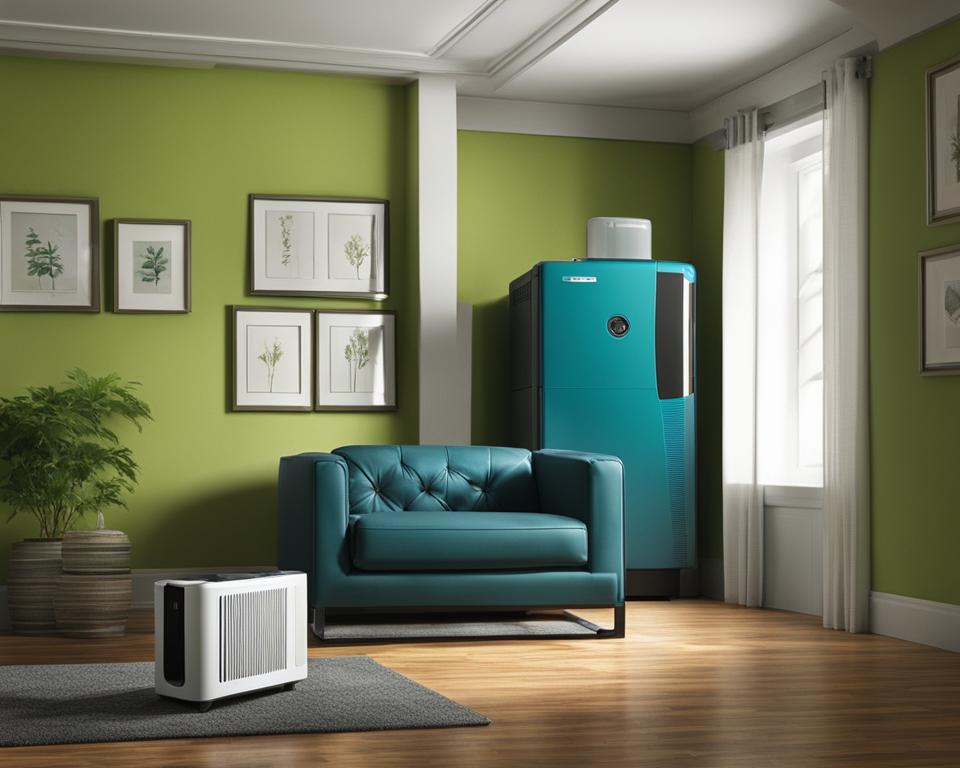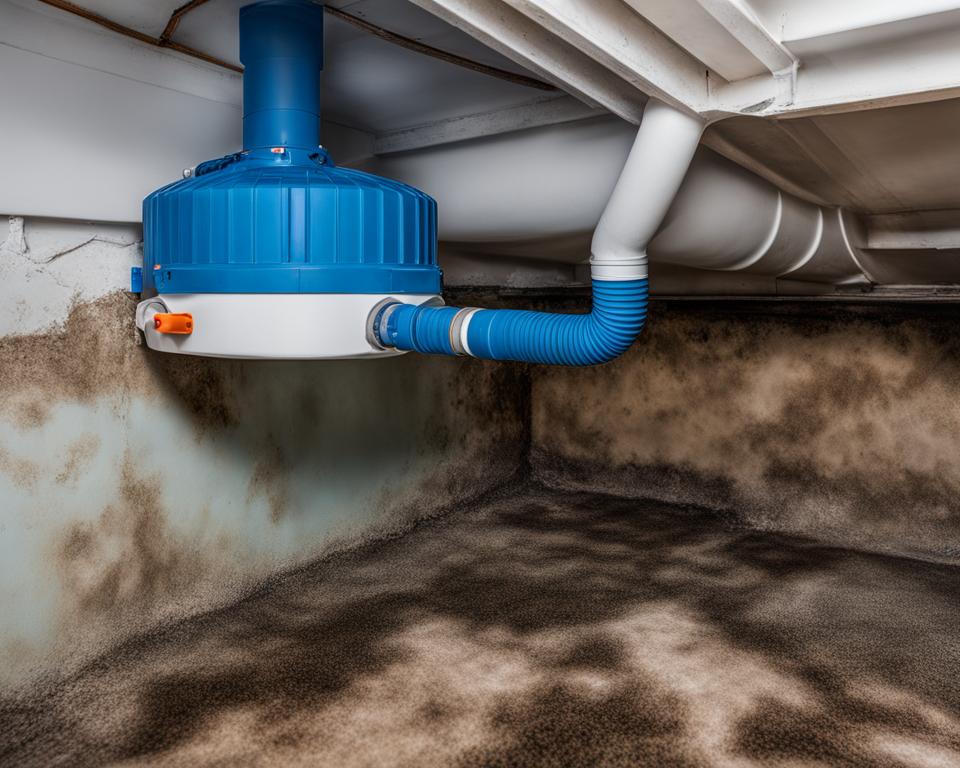Mold prevention is a crucial aspect of maintaining a healthy and safe living environment. One effective technique to prevent mold growth is by using crawl space dehumidifiers. These devices are designed to lower humidity levels in crawl spaces, which is essential for proper mold remediation and prevention. However, it is important to note that dehumidifiers are not meant to kill mold; their main function is to control moisture levels.
When it comes to mold prevention, it is vital to understand the connection between moisture and mold. Mold requires a source of moisture to thrive and reproduce. By controlling the moisture levels in crawl spaces, homeowners can effectively prevent mold growth. Crawl space moisture control techniques, such as using dehumidifiers and addressing water leaks, play a crucial role in ensuring a mold-free environment.
Key Takeaways:
- Crawl space dehumidifiers are effective in preventing mold growth by controlling moisture levels.
- Dehumidifiers do not kill mold but help create an environment that is inhospitable for its growth.
- High humidity and moisture provide the perfect conditions for mold to flourish.
- Mold prevention should be done by certified professionals in addition to using dehumidifiers.
- Scientific studies have shown the effectiveness of dehumidification in reducing mold growth.
The Role of Dehumidifiers in Mold Prevention
Dehumidifiers play a crucial role in mold prevention by controlling humidity levels in crawl spaces. High humidity creates ideal conditions for mold growth. By using crawl space dehumidifiers, homeowners can effectively lower the humidity levels and prevent mold from spreading. Along with crawl space ventilation, dehumidifiers help to create a dry environment that inhibits mold growth. These techniques are essential for maintaining a healthy and mold-free crawl space.
Excess moisture in crawl spaces can lead to various problems, including mold growth, wood rot, and structural damage. Crawl spaces are prone to high humidity due to their location below ground level and lack of adequate ventilation. This creates a favorable environment for mold spores to thrive and spread. By installing dehumidifiers in crawl spaces, homeowners can actively control the humidity levels and reduce the risk of mold growth.
Benefits of Crawl Space Dehumidifiers:
- Prevents mold growth: Dehumidifiers help to create a dry environment that inhibits mold spore germination and growth. By maintaining the humidity levels between 30-50%, dehumidifiers effectively prevent mold from spreading.
- Improves air quality: Mold spores can cause respiratory issues and allergies. By reducing the moisture content in the air, dehumidifiers contribute to better indoor air quality, promoting a healthier living environment.
- Protects property: High humidity can lead to moisture-related damage such as wood rot, peeling paint, and musty odors. Dehumidifiers help to preserve the integrity of the crawl space, preventing costly repairs and property damage.
In combination with proper crawl space ventilation, dehumidifiers are an effective mold prevention technique. Ventilation allows fresh air to circulate in the crawl space, reducing the chances of moisture buildup. When paired with dehumidifiers, ventilation helps to maintain optimal humidity levels and further enhances mold prevention efforts. It is important to note that both dehumidifiers and ventilation should be properly sized and installed to ensure maximum effectiveness in controlling moisture and mold growth.
| Dehumidifier Type | Advantages | Disadvantages |
|---|---|---|
| Mechanical Dehumidifiers | – Effective in reducing humidity levels – Affordable option – Easy maintenance |
– Generates noise – Consumes more energy |
| Absorption Dehumidifiers | – Quiet operation – Energy efficient – Suitable for low-temperature environments |
– Higher initial cost – Requires periodic maintenance |
| Electronic Dehumidifiers | – Energy efficient – Compact and portable – Low maintenance |
– Higher initial cost – Less suitable for large spaces |
The Connection Between Moisture and Mold
Moisture is a key factor in mold growth. Mold requires a source of moisture to thrive and reproduce. By controlling the moisture levels in crawl spaces, homeowners can effectively prevent mold growth. High humidity, water leaks, and damp materials provide the perfect environment for mold to flourish. Crawl space moisture control techniques, such as using dehumidifiers and addressing water leaks, are vital for preventing mold and ensuring a healthy living environment.
The Role of Moisture in Mold Growth
Excess moisture in crawl spaces creates ideal conditions for mold spores to colonize and grow. Mold spores are constantly present in the air, but they require moisture to germinate and form mold colonies. When humidity levels rise above 60%, the risk of mold growth increases significantly. Damp materials, such as wood, insulation, and fabric, also contribute to elevated moisture levels and provide organic matter for mold to feed on.
The Importance of Moisture Control in Crawl Spaces
Controlling moisture in crawl spaces is essential for preventing mold growth and maintaining a healthy living environment. Several moisture control techniques can be implemented, including:
- Using crawl space dehumidifiers to reduce humidity levels
- Repairing water leaks and sealing crawl space vents
- Installing vapor barriers to prevent moisture infiltration
- Improving drainage around the foundation to prevent water accumulation
By implementing these moisture control strategies, homeowners can effectively inhibit the growth of mold and create a dry, inhospitable environment for mold spores.

How Dehumidifiers Fight Mold
Dehumidifiers are a crucial tool in the fight against mold. Mold thrives in areas with high humidity, so by reducing the levels of moisture in the air, dehumidifiers create an environment that is inhospitable for mold growth. These devices work by removing excess moisture from the air, effectively lowering the relative humidity and preventing the conditions that mold needs to flourish.
There are different types of dehumidifiers available, including mechanical, absorption, and electronic models. Each type utilizes various technologies to achieve the goal of moisture control. Mechanical dehumidifiers use a fan, condenser coils, and a refrigerant to extract moisture from the air, while absorption dehumidifiers use a desiccant to absorb moisture. Electronic dehumidifiers utilize a cooling or heating element to remove moisture from the air. No matter the type, dehumidifiers significantly reduce the chances of mold growth and help to maintain a mold-free environment.
By investing in a dehumidifier, homeowners can take proactive steps towards mold prevention. These devices are especially effective in areas with high humidity levels, such as basements, crawl spaces, and bathrooms. When using a dehumidifier, it is important to regularly empty and clean the water tank to prevent mold or bacteria buildup. Additionally, it is essential to properly size the dehumidifier for the space it will be used in to ensure optimal performance.

Benefits of using dehumidifiers for mold control:
- Reduces excess moisture in the air, making it difficult for mold to grow
- Helps to create a dry environment that inhibits mold growth
- Improves indoor air quality by reducing musty odors
- Protects furniture, carpets, and other belongings from mold damage
- Creates a more comfortable living environment by reducing humidity
Factors to consider when choosing a dehumidifier:
- The size of the space where the dehumidifier will be used
- The humidity levels in the area
- The desired moisture removal capacity
- The noise level of the dehumidifier
- The energy efficiency rating
In conclusion, dehumidifiers play a crucial role in mold prevention by reducing moisture levels in the air. By investing in a dehumidifier and using it properly, homeowners can effectively fight against mold growth and maintain a healthy living environment.
The Effectiveness of Dehumidifiers in Mold Prevention
Scientific studies have substantiated the efficacy of dehumidifiers in preventing mold growth. Extensive research conducted at the University of Cincinnati revealed a clear correlation between dehumidification and a reduction in mold growth. The study focused on day care centers and demonstrated that the integration of dehumidifiers, in conjunction with air filtration, effectively controlled indoor relative humidity and airborne fungal spores.
A separate case study conducted by a leading commercial dehumidifier manufacturer showcased remarkable success in preventing mold growth in a brewery environment. By utilizing desiccant dehumidification, the reduction of moisture levels contributed significantly to inhibiting the growth of mold. The results were undeniable, solidifying the importance of dehumidifiers as an effective mold prevention solution.
Emphasizing the significance of humidity and moisture control, the Environmental Protection Agency (EPA) consistently underscores the role of dehumidifiers in mold prevention. Recognizing the pivotal connection between mold growth and excess moisture, the EPA advocates for the use of dehumidifiers as a proactive measure to maintain a mold-free environment.
In conclusion, scientific evidence, real-life case studies, and the endorsement of reputable organizations such as the EPA all concur on the effectiveness of dehumidifiers in mold prevention. As homeowners and property owners alike seek viable solutions to combat mold growth, incorporating dehumidification measures proves to be a reliable and proven approach in safeguarding against mold and maintaining a healthy living environment.
FAQ
Do dehumidifiers kill mold?
No, dehumidifiers are not designed to kill mold. Their primary purpose is to lower humidity levels in crawl spaces, which helps to prevent mold growth. Mold removal should be done by certified professionals in addition to using dehumidifiers for effective mold prevention.
How do crawl space dehumidifiers prevent mold growth?
Crawl space dehumidifiers play a crucial role in mold prevention by controlling humidity levels. By lowering the humidity, homeowners can effectively create a dry environment that inhibits mold growth. Coupled with crawl space ventilation, dehumidifiers help to maintain a healthy and mold-free crawl space.
Why is moisture control important for mold prevention?
Moisture is a key factor in mold growth. Controlling the moisture levels in crawl spaces is vital for preventing mold. High humidity, water leaks, and damp materials provide an ideal environment for mold to thrive. By addressing water leaks and using dehumidifiers, homeowners can effectively prevent mold and ensure a healthy living space.
How do dehumidifiers work in preventing mold?
Dehumidifiers work by reducing the levels of relative humidity in the air. They remove excess moisture from the air, creating an inhospitable environment for mold. Different types of dehumidifiers, such as mechanical, absorption, and electronic dehumidifiers, use various technologies to achieve moisture control. By using dehumidifiers, homeowners significantly reduce the chances of mold growth and maintain a mold-free environment.
Are dehumidifiers effective in mold prevention?
Scientific studies have shown the connection between dehumidification and a reduction in mold growth. Research conducted at the University of Cincinnati and case studies from commercial dehumidifier manufacturers demonstrate the effectiveness of dehumidifiers in controlling humidity and preventing mold growth. Dehumidifiers are a proven and effective solution for mold prevention.

Leave a Reply